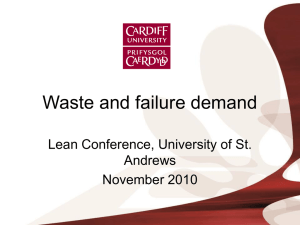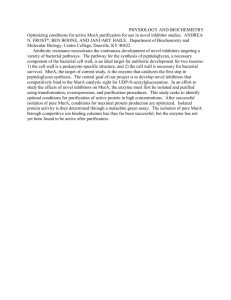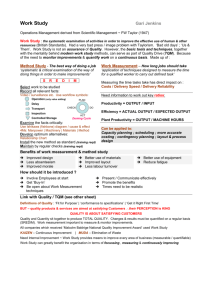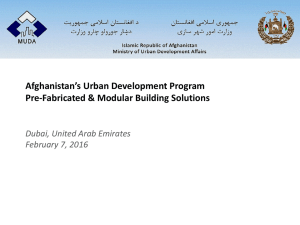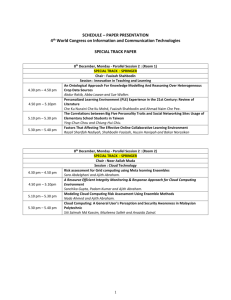Waste reduction by MUDA, MURA and MURI MUDA, MURA & MURI
advertisement
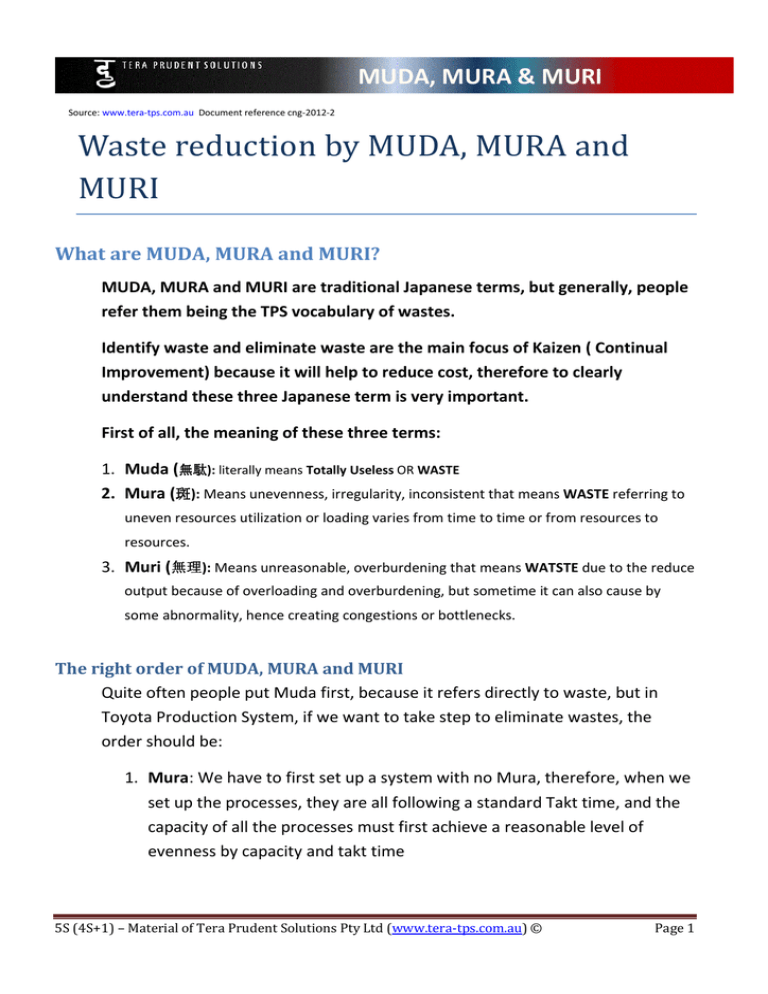
MUDA, MURA & MURI Source: www.tera-tps.com.au Document reference cng-2012-2 Waste reduction by MUDA, MURA and MURI What are MUDA, MURA and MURI? MUDA, MURA and MURI are traditional Japanese terms, but generally, people refer them being the TPS vocabulary of wastes. Identify waste and eliminate waste are the main focus of Kaizen ( Continual Improvement) because it will help to reduce cost, therefore to clearly understand these three Japanese term is very important. First of all, the meaning of these three terms: 1. Muda (無駄): 無駄 literally means Totally Useless OR WASTE 2. Mura (斑): Means unevenness, irregularity, inconsistent that means WASTE referring to uneven resources utilization or loading varies from time to time or from resources to resources. 3. Muri (無理): 無理 Means unreasonable, overburdening that means WATSTE due to the reduce output because of overloading and overburdening, but sometime it can also cause by some abnormality, hence creating congestions or bottlenecks. The right order of MUDA, MURA and MURI Quite often people put Muda first, because it refers directly to waste, but in Toyota Production System, if we want to take step to eliminate wastes, the order should be: 1. Mura: We have to first set up a system with no Mura, therefore, when we set up the processes, they are all following a standard Takt time, and the capacity of all the processes must first achieve a reasonable level of evenness by capacity and takt time 5S (4S+1) – Material of Tera Prudent Solutions Pty Ltd (www.tera-tps.com.au) © Page 1 MUDA, MURA & MURI Source: www.tera-tps.com.au Document reference cng-2012-2 2. Muri: When Mura is in place, Muri will quickly surfaced, there are areas where Muri can occurred beyond the consideration of Mura such as high defect ratio, bottle necking due to difficult operation, 3. Muda: Once the Mura and Muri had been sorted out, then it will be time to identify Muda in all the operations, material usage, defects etc. There are altogether 7 types of wastes (TIMWOOD): T: Transportation: Muda in transportation in term of loads and distance travelled I: Inventory: Muda of unnecessary stocks due to untimely delivery, buffers for abnormality, over-processing and over-production M: Motion: Muda of motion, walking due to location of materials and works W: Wait: Muda due to idle time, usually due to waiting for machine to complete cycle, material not delivered on time etc.. O: Over-processing: Muda due to over- processing ahead of required, this is very visual when inventory piling up long before it needed for next process. O: Over-production: Muda due to over- producing, hence the inventory of final stock goes up, it needs additional space to store them, and it make tracing of stock and quality very difficult D: Defect: Muda due to producing defect, if this is not eliminated, the cost will go up because of wastage in materials, process labour and the labour to repair and tracking. 5S (4S+1) – Material of Tera Prudent Solutions Pty Ltd (www.tera-tps.com.au) © Page 2 MUDA, MURA & MURI Source: www.tera-tps.com.au Document reference cng-2012-2 Why do you need to learn and apply MUDA, MURA and MURI? It is very obvious why you need to learn and apply MUDA, MURA and MURI. Simply wastes are not desirable, they need to be identified and eliminated, therefore by knowing MUDA, MURA and MURI, the whole organization can take meaningful steps to eliminate wastes and hence improving cost. How to implement Waste elimination by adopting knowledge of MUDA, MURA and MURI? First of all Tera Prudent Solution will carry out assessment of current stage of the knowledge about waste reduction in your organization. This will involve a half day interview with your front line managers and shop floor observation. Then, there will be another half a day of class room session to introduce the concepts of concept of MUDA, MURA and MURI and the steps to identify and reduce waste. To cover MUDA, MURA and MURI thoroughly, it is necessary to understand all the basic of TPS such as 4S +1, Takt Time, Standardized Works and etc. Usually, it is recommendable that you should introduce TPS standardized works first, but depend on the level of standardization in your company; it is possible to implement waste reduction by MUDA, MURA and MURI. The third stage is the formation of small group activities to implement waste reduction and Kaizen activities. If there are no visual displays and meeting place at shop floor, it will be the right time to start at this point. Following that, it will be 4 hours visit very fortnight for three months. In summary, there will be 2 by 4 hours class room session, and 8 x 4 hours on site follow up. Tera Prudent Solutions will summarize the activities and make a report to the management at end of the 4th month and recommend further supports. 5S (4S+1) – Material of Tera Prudent Solutions Pty Ltd (www.tera-tps.com.au) © Page 3
